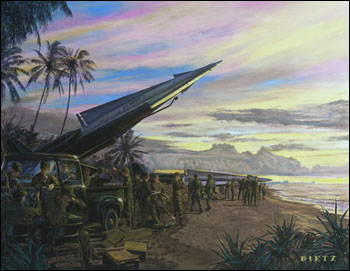
Members of Hawaii's 298th Artillery Group prepare to test fire their Nike Hercules missiles at the Oahu Test Range
Heritage Series
1966Oahu, Hawaii - With the onset of the Cold War and the threat of long-range Soviet nuclear bombers, the Guard wrote a new chapter in its history of homeland defense. Beginning in 1954, thousands of Army Guardsmen manned antiaircraft artillery positions across the country, adopting for the first time a federal mission while in a state status. In the late 1950s the Guard began transitioning from guns to longer-ranged and more lethal missiles. For exactly 16 years, from September 1958 to September 1974, the Army Guard manned Nike-Ajax and Nike-Hercules missile batteries in an operational status. At the height of the program in 1969, 17 states (CA, CT, HI, IL, MD, MA, MI, MO, NJ, NY, OH, PA, RI, TX, VA, WA, WI) provided more than 7,000 soldiers to staff 54 missile batteries around sixteen key metropolitan areas. The Hawaii Guard's 298th Artillery Group was the first National Guard unit to adopt the Nike-Hercules missile, becoming operational in early 1960. Hawaii was also the only state to man all of its firing batteries with Guardsmen; in the continental United States the Guard manned about a third of all Nike sites. While the rest of the Nike force conducted its annual live fire practices at the White Sands Missile Range in NM, the Hawaii Guard was unique in that it conducted its annual live-fire certifications from mobile launchers firing off the north shore of the island of Oahu. It was during such an exercise that Battery B, 1st Missile Battalion, 298th Artillery Group recorded the longest successful Nike-Hercules missile intercept of a target. The advent of the intercontinental ballistic missiles in the 1960s led to cut backs in the Nike program by the early 1970s. The entire program ended in 1974. Though no missile was ever fired in anger, the duty encompassed a 24-hour watch, 365 days a year and thousands of alerts. Guardsmen had demonstrated their ability to conduct real-world missions while in a part-time, state-controlled, status, in the process proudly adopting for themselves the title "Missile-Age Miuntemen."